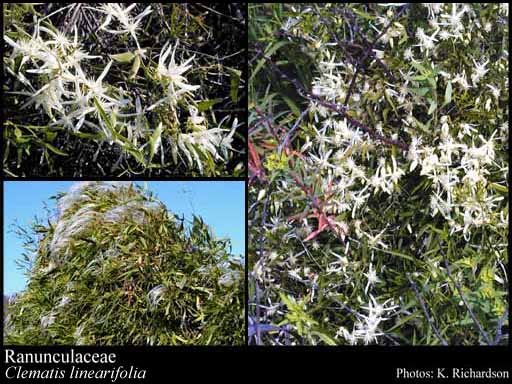- Reference
- Gen.Pl. [Jussieu] 231 (1789)
- Name Status
- Current

Scientific Description
Common name. Buttercup Family.
Habit and leaf form. Herbs (mostly), or shrubs (Xanthorhiza), or lianas (Clematis); without essential oils. Annual to perennial; plants with a basal concentration of leaves, or with neither basal nor terminal concentrations of leaves; often rhizomatous, or tuberous. Self supporting, or climbing. Hydrophytic to mesophytic; when hydrophytic, rooted. Leaves of aquatics emergent, or submerged, or submerged and floating. Heterophyllous (commonly, when hydrophytic), or not heterophyllous. Leaves alternate (usually), or opposite (Clematis); usually spiral; petiolate; sheathing. Leaf sheaths with free margins. Leaves without marked odour, or foetid; simple, or compound; peltate (more or less, occasionally), or not peltate; epulvinate; when compound pinnate, or palmate, or bipinnate, or multiply compound. Leaf blades when simple dissected, or entire; when simple/dissected palmately lobed, or much-divided; pinnately veined, or palmately veined; cross-venulate (usually), or without cross-venules. Leaves with stipules (commonly rather conspicuously so), or without stipules. Stipules intrapetiolar. Leaf blade margins entire, or crenate, or serrate, or dentate. Leaves without a persistent basal meristem. Leaf anatomy. Hydathodes present (occasionally), or absent. Stem anatomy. Nodes unilacunar (rarely), or tri-lacunar to multilacunar. Secondary thickening absent (commonly), or developing from a conventional cambial ring.
Reproductive type, pollination. Fertile flowers hermaphrodite, or functionally male, or functionally female. Unisexual flowers present, or absent. Plants hermaphrodite, or dioecious (rarely, by suppression). Floral nectaries present (usually), or absent (e.g. Anemone, Clematis, Thalictrum). Nectar secretion from the perianth, or from the androecium (from the bases of the petals, considered staminodial in origin). Entomophilous (usually — attracting insects by either nectar or pollen), or anemophilous (e.g. Thalictrum).
Inflorescence and flower features. Flowers solitary (often pedunculate), or aggregated in ‘inflorescences’; in cymes, or in racemes, or in panicles. The terminal inflorescence unit cymose. Inflorescences scapiflorous, or not scapiflorous; terminal, or axillary; various, but determinate. Flowers small to medium-sized; regular (usually), or somewhat irregular to very irregular (Aconitum etc.); cyclic (Aquilegia), or partially acyclic, or acyclic. When more or less acyclic the perianth acyclic, the androecium acyclic, and the gynoecium acyclic, or the androecium acyclic and the gynoecium acyclic, or the gynoecium acyclic. Floral receptacle not markedly hollowed (convex or elongated). Free hypanthium absent. Hypogynous disk absent. Perianth with distinct calyx and corolla, or sequentially intergrading from sepals to petals, or sepaline, or petaline; 5–50 (to ‘many’); free, or joined. Calyx when definable (3–)5–8 (or more, often becoming petaloid); polysepalous, or partially gamosepalous, or gamosepalous; imbricate, or valvate; spurred, or neither appendaged nor spurred; persistent, or not persistent. Corolla when definable 3–50 (to ‘many’ — perhaps staminodal in origin); polypetalous, or partially gamopetalous, or gamopetalous; imbricate; green, or white, or yellow, or red (e.g. some Aquilegia species), or purple, or blue; spurred (occasionally), or not spurred (or with little tubular nectariferous ‘petals’). Petals clawed, or sessile. Fertile stamens present, or absent (rarely, in Clematis). Androecium 15–100 (usually ‘many’). Androecial members unbranched; maturing centripetally; free of the perianth; free of one another; 1–13 -whorled (or spiralled). Androecium including staminodes. Staminodes usually several or many, if nectaries of various kinds between perianth and stamens are interpreted as such; petaloid, or non-petaloid. Stamens (5–)10–100 (usually ‘many’). Anthers adnate; non-versatile; dehiscing via longitudinal slits, or dehiscing by longitudinal valves (e.g. Trautvetteria); extrorse, or latrorse; tetrasporangiate. Fertile gynoecium present, or absent (rarely, when male). Gynoecium (1–)3–100 carpelled (i.e. to ‘many’). The pistil 1 celled (rarely), or 3–5 celled. Gynoecium monomerous, or apocarpous, or syncarpous; of one carpel (Actaea), or eu-apocarpous (nearly always), or semicarpous (carpels sometimes more or less connate, e.g. Aquilegia), or synovarious (e.g. Nigella); superior. Carpel non-stylate, or stylate; apically stigmatic; (when monomeric or apocarpous) 1 ovuled, or 2–100 ovuled (‘several to many’). Placentation when monomeric or apocarpous marginal, or basal. Ovary plurilocular; when syncarpous, 3–5 locular. Styles apical. Stigmas dry type; papillate, or non-papillate; Group II type. Placentation when syncarpous, axile. Ovules when syncarpous, 3–15 per locule; pendulous, or horizontal, or ascending; with ventral raphe to with dorsal raphe; non-arillate; hemianatropous, or anatropous.
Fruit and seed features. Fruit non-fleshy (usually), or fleshy (rarely); an aggregate (usually), or not an aggregate. The fruiting carpel dehiscent, or indehiscent; a follicle, or an achene, or baccate (Actaea). Fruit when syncarpous, dehiscent; when syncarpous a capsule (e.g. Nigella). Seeds copiously endospermic. Endosperm oily. Seeds without amyloid. Embryo rudimentary at the time of seed release to weakly differentiated, or well differentiated. Cotyledons 1 (occasionally), or 2 (often connate). Embryo achlorophyllous (14/25); straight. Seedling. Germination phanerocotylar, or cryptocotylar.
Physiology, biochemistry. Aluminium accumulation not found. Photosynthetic pathway: C3.
Geography, cytology, number of species. World distribution: cosmopolitan, concentrated in the North temperate. 1500 species.
Economic uses, etc. Many cultivated ornamentals (Ranunculus, Anemone, Helleborus, Trollius, Delphinium, Aconitum, Aquilegia, some (e.g. Aconitum) supply poisonous narcotic drugs.
Keys
Western Australian Genera and Families of Flowering Plants — an interactive key
T.D. Macfarlane, L. Watson, N.G. Marchant